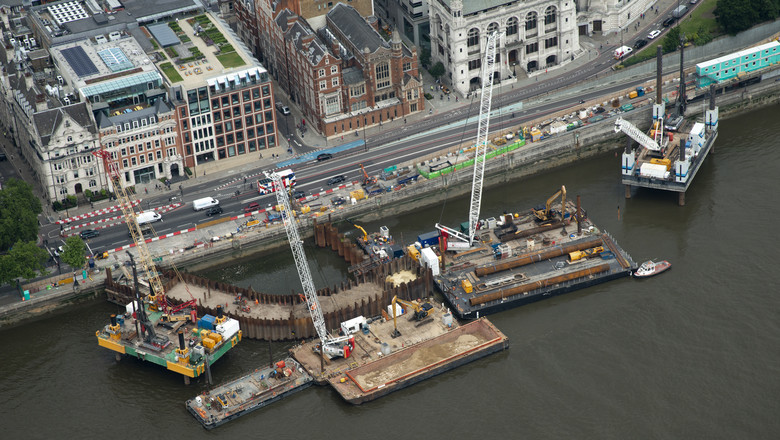
Successful security
solutions at London's Thames Tideway Tunnel

When it comes to securing large-scale construction projects, planning is everything. This has proved crucial at London’s Thames Tideway Tunnel, where G4S has been working round the clock to keep the site and its people safe.
The £4.2 billion, 25km super-sewer is designed to prevent millions of tonnes of raw sewage spilling into the River Thames each year. Construction is well underway across 23 of the 24 construction sites.
Flexible and reliable security
Protecting such a major infrastructure project is no easy task. Based on the same Effects-Based Security Design principles used at critical infrastructure sites such as the Hinkley Point C nuclear power station, the extensive planning that went into creating the programme has paid off.
A multi-skilled workforce
G4S personnel are spread across 19 construction sites, which span some 25km of the city. “The team is divided into three, with a third deployed in each of the construction zones,” explains Halse. “We have an account director, three zone managers and a number of supervisors in each zone, who look after the personnel delivering the service on the ground. It’s a rigid and lean organisational structure that works well.”
To ensure a high quality service across all sites, training has been a crucial factor from the word go. “Once we moved into the operational phase and our workforce numbers steadied, we were able to really start focusing on training and development,” says Halse. This is carried out on-the-job and in the classroom, covering everything from traffic marshal and CCTV training to access control. It also includes Construction Skills Certification Scheme qualifications and specific training from Thames Water.
“All our personnel are now multi-skilled across the construction sites, so we can easily move people from site to site and zone to zone if needed,” explains Halse. “These skills are also highly transferable. So, when this project winds down, they can transfer to another G4S project and take all those skills with them.”
Technological enhancements
Alongside a fluid and highly skilled workforce, technology is another hugely important part of the security programme at the Thames Tideway Tunnel.
“The plan we initially had in place to create a unique identity card for every person working on site is working extremely well. G4S has deployed its Symmetry System across the sites,” says Halse.
The success of the programme has prompted the main works contractors to make exponential investments in technology over the past year, far beyond what was proposed in G4S’ original bid for the project in 2014. “As more sites become operational, the contractors are seeing the added value of these technologies,” says Halse.
G4S technologies used on site include thermal, infrared and pan–tilt–zoom (PTZ) cameras, “As well as the sites themselves, we also monitor the foreshore,” says Halse. “This way we can see everything that comes in from the riverbank.” Moreover, automatic number plate recognition is now part of the offering, which identifies vehicles approaching the work sites, their cargo, time of arrival and whether they have been granted access.
The G4S team has also worked closely with the contractors to increase security measures and improve access control across the sites’ office accommodation.
All CCTV and access control data feeds back to the bespoke G4S control centre, which is monitored by our G4S security personnel 24 hours a day. “As more of the work sites come online, we’ve linked more technology into the centre, so it’s becoming more advanced and efficient,” says Halse.
Keeping people safe
With operations now 24/7, these security measures are more important than ever. “We have two main concerns: protecting the sites and the equipment, and keeping people safe,” says Halse.
“For huge construction sites like this, we need to preserve the integrity of the perimeters to make sure that nobody causes damage. We do this by ensuring that our physical, technical and tactical principals of security are applied,” explains Halse.
The other key risk is around people, because of the significant increase in activity and footfall on site. “The contractors are building huge pieces of infrastructure to cater for upcoming work, and there’s been a rise in waterside activity, with project waste being removed by barge and reclaimed land being built into the Thames,” says Halse.
In addition to this activity and the day-to-day workforce, there are construction specialists, drilling teams and equipment assembly teams, as well as a number of transient people coming on and off site to complete smaller tasks.
We are passionate about safety, and Tideway agrees that we must do things safely, or not at all. Every pair of feet that comes on site is exposed to risk so it’s about making sure they’re safe, and, when we identify a non-safe activity, we know it’s in our power to stop it.”
“What we’ve planned in the past is in fruition now,” says Halse. “We’re being innovative, we’re looking for efficiencies and we’re a respected member of the alliance partnership. Our footprint and impact are being increasingly recognised and the people we work with see G4S as a truly credible partner on this dynamic project.”
